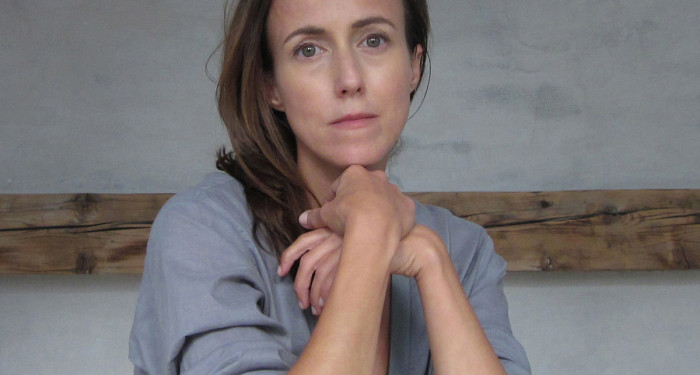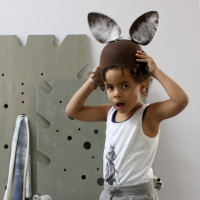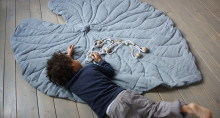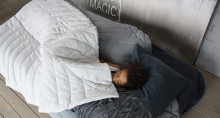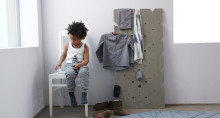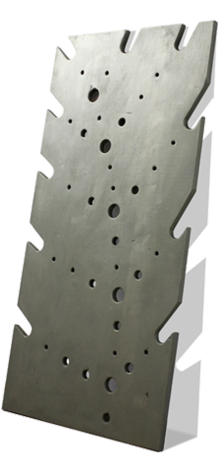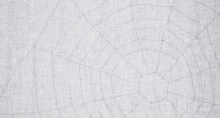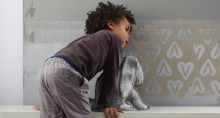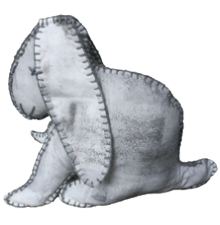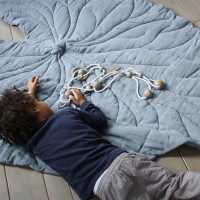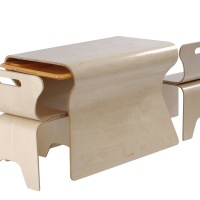Interior architect and product designer Sabine Fajana launched her heirloom family interiors brand, Vividgrey, in 2013. Based in Vienna, Vividgrey evolved out of Sabine’s career working with luxury brands and her adventures in motherhood with her son Raven, who is now five.
What inspired you to create Vividgrey? A whole new world opened up when I became a mother. I started to create furnishings for our home that would make us both happy. Combining simple aesthetics with refined details and hidden elements, I wanted the pieces to feel ‘precious’ rather than ‘luxurious’; unique items crafted by hand that would carry precious memories, all there to be discovered by children. Of course, developing my own brand also evolved from my work as an interior architect for luxury brands and the meeting of this with my own experience of motherhood.
Where did your love of unique handmade pieces come from? A lot of things that I grew up with were handmade by my grandmother or mother – I have wonderful memories of our clothes, which were lovingly handmade. For holidays, my sister and I wore matching dresses in different sizes, often with little embroidered details that would be picked up in my mother’s outfit, too. We always felt very special wearing these clothes.
What are your most vivid childhood memories? I remember the delicious feeling of freedom I experienced during family holidays on the island of Corsica. We spent an entire month there each summer for much of my childhood. We could roam around the beach and rocks as a group of kids, unattended by parents. I spent endless hours exploring seawater puddles and the amazing wildlife that had gathered inside – gorgeous shells and tiny crabs. I was, and still am, very fond of these creatures.
What makes Vividgrey stand out from the crowd? Vividgrey is a rare combination of the wild and the serene – subtle and poetic products are balanced with more intuitive ones made of torn fabrics or that use bold printing methods. But what is perhaps even more unique to our brand is the subtle ways in which we attempt to capture both children’s and grown-up’s imaginations. I want to inspire and surprise but also to create products that are timeless and lasting.
Which pieces embody this philosophy? The Magic Curtain is a poetic take on making time stand still: a delicate cobweb is sewn (without an exact pattern, making each one unique) on textured linen voile with frayed edges, balancing the raw with the refined. The magic happens when the curtains are backlit, subtly embodying the wish to make time – like the years shared with young children – stand still. I made it when my son Raven was a baby and I realized that time is so transient. It’s an understated piece that transforms to being magical when the light shines through.
How are your pieces made? Most pieces are made to order in our workshop in Vienna. All textiles are dyed on the premises, which means that no batch is exactly the same. This also adds to the quality of the finished item and it is lovely when big panels of fabrics are hung out to dry. Each item is finished off with the screen-printed logo and care instructions, which are done manually. I also feel that creating modern heirlooms can only be achieved by using materials that do good to people all along the manufacturing process. This is how I started to research into FairTrade and organic materials in depth.
Tell us about your eco credentials… We always use Fair Trade fabrics from certified suppliers or linens that are made locally by an Austrian weaver. The only wadding material we use is organic cotton, which we buy from another GOTS certified manufacturer. Some of our cotton fabrics are manually woven on handlooms, providing employment to a south Indian Fair Trade cooperation. Our stationery and packaging is made of recycled paper made by a British employee-owned cooperative with FSC certification. Any timbers we use for our pieces are either reclaimed or of sustainable European source. All these materials come at a higher cost, but social and environmental responsibility is hugely important for our brand ethics. We want to do good with what we do.
As a child, what colours did you like? I was born in the Seventies, so everything around me was rather colourful. The bedroom I shared with my older sister was full of bold primary colours with green carpets and yellow walls adorned with blue heart prints. My mother was very creative and made potato stencils with a heart print, and my sister and I were then allowed to decorate the walls with this print.
What’s your favorite colour now? At the moment, it’s a clear grey tone, which I’ve just used for dying some bedlinen. It’s lovely and fresh. I do change my preferences, but I don’t think it is difficult to guess that I generally favour all sorts of greys.
Some people might consider grey to be dull and dreary. What’s your take on that? But no grey is the same! There is so much variety within that colour palette and it can create a lively but harmonious backdrop to everyday life. Children benefit from a visually restful home, as there will always be bold colours brought into it through children’s toys and products. Our name Vividgrey does not necessarily refer to a colour, but tries to capture the diversity of the brand – the imagination and vibrancy of children balanced with the simple sophistication found in the grown-up world. The grey shades used throughout the Vividgrey collection are not necessarily matching, but they work well together.
Are there any designers and architects you admire? I find artist Gordon Matta Clark’s Anarchitecture projects from the Seventies so amazing. And I admire sculptor Rachel Whiteread, the first woman to win the prestigious Turner Prize in 1993, as well as the young French contemporary artist Noemie Goudal who blends the real with the surreal in such an engaging visual way. I love installations that interact with nature and the outdoors, like Finnish architect Marco Casagrande’s ‘Sandworm’ or the textures of colourful leaves, stones and water in British sculptor, photographer and environmentalist Andy Goldsworthy’s projects. I also find some of Indian sculptor Anish Kapoor’s sculptures very engaging (you can also check out his most recent works on the fabulous Artsy website…)
What are your most treasured possessions? It might sound predictable, but it’s things that cannot be replaced: our family photographs that date back generations; clothes that were handmade by my beloved, late grandmother; or my son’s drawings. These are things that money can’t buy – or replace.
How do you see the brand evolving? I want to see the collection itself evolve while maintaining the manufacturing ethics established for the brand. I would also love to collaborate with selected hotels, spas or resorts that share our values.

